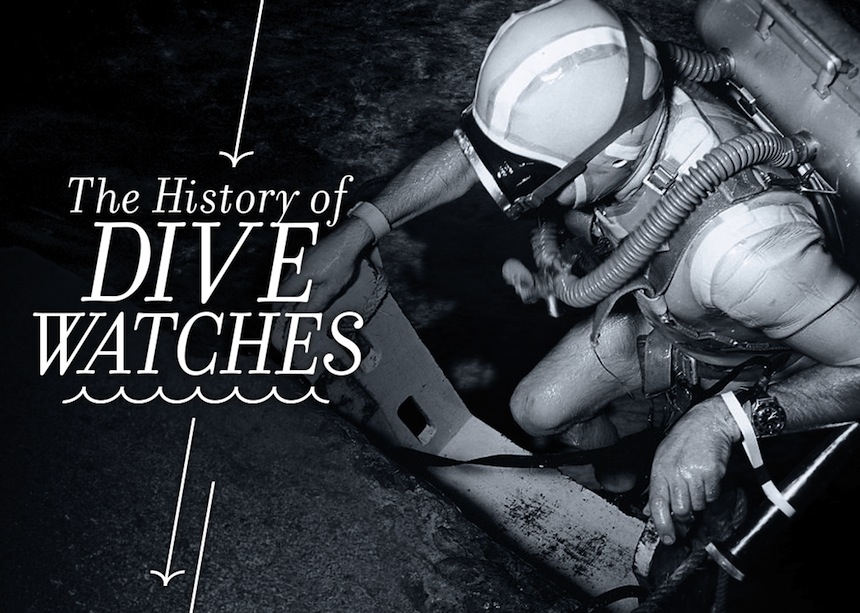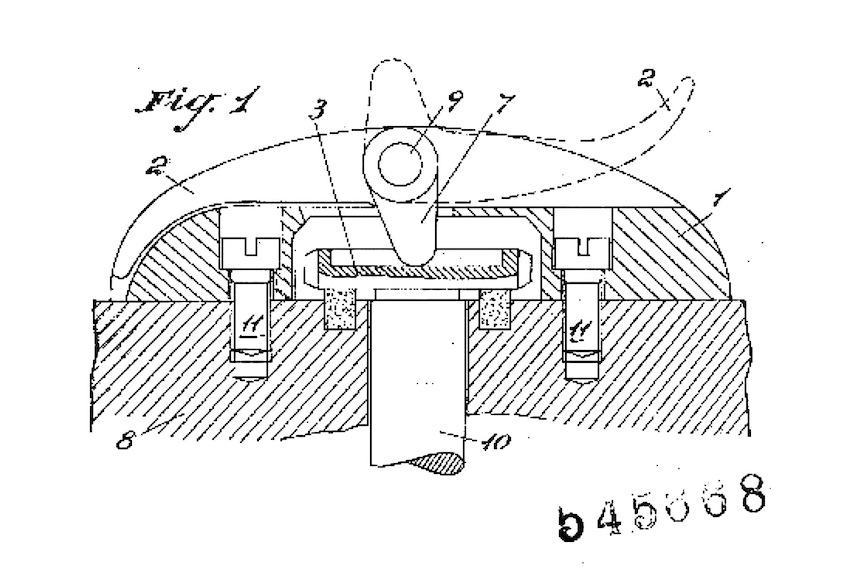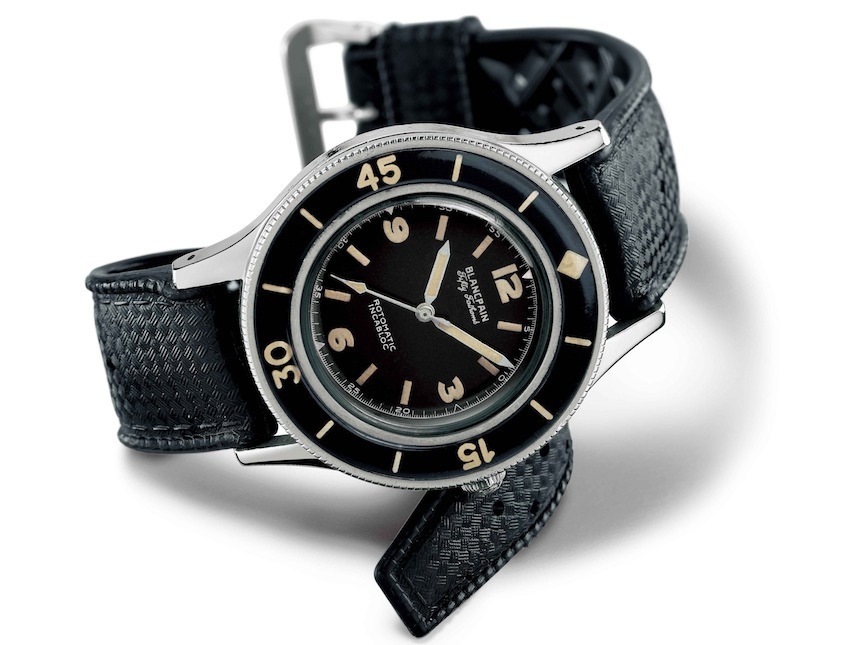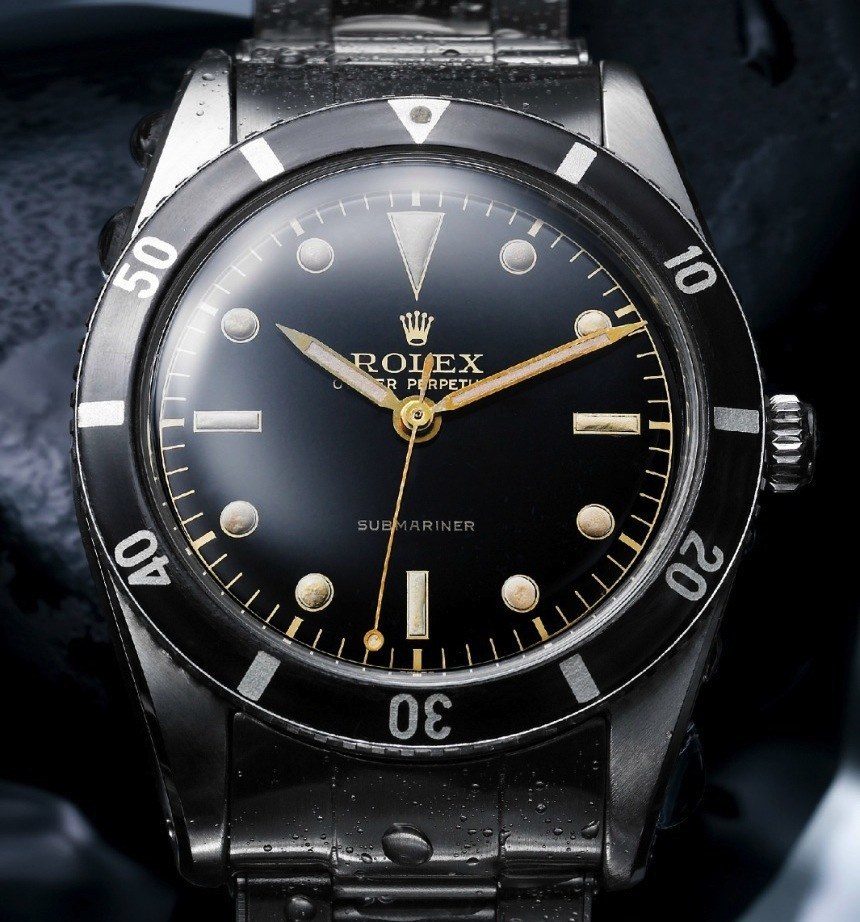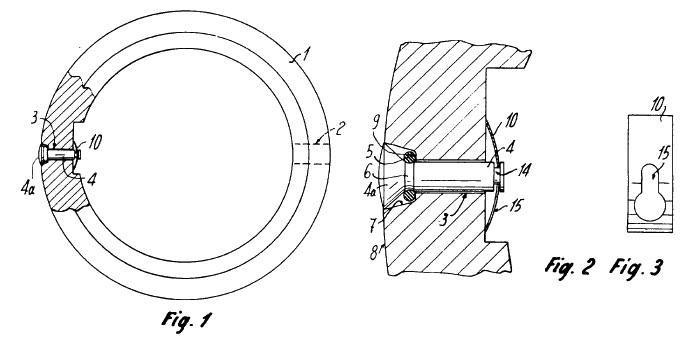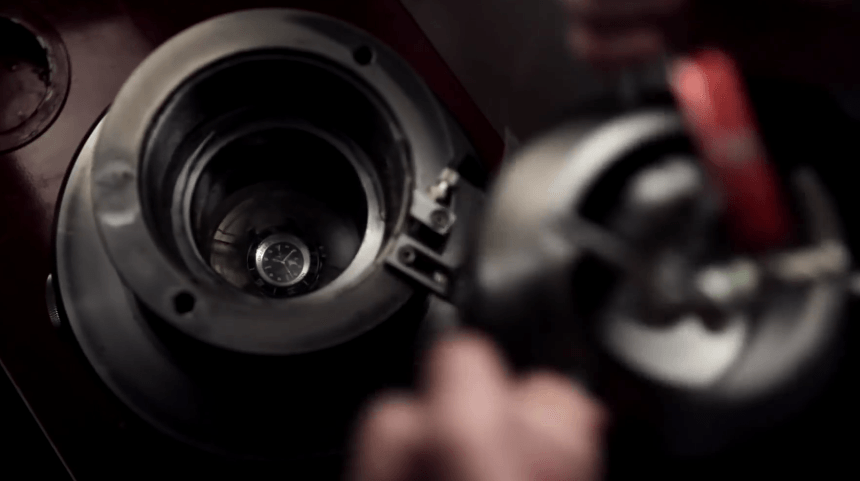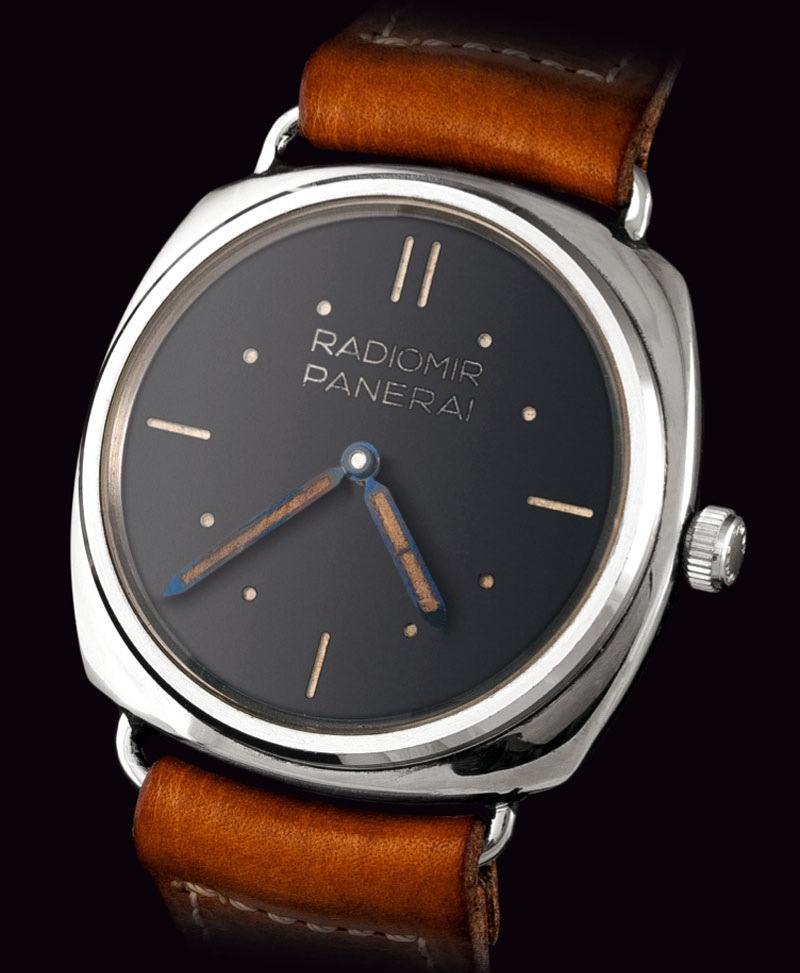
An extremely early version of the Panerai “Radiomir” 2533 from 1936. Source: paneraiworld.blogspot.com
The story continues right around where it ended with the Oyster: the main challenges remained properly sealing the crown and the case and making the watch more legible when used under water. Among the first, and definitely the most peculiar brands is the then-Florentine Officine Panerai. Panerai supplied the Regia Marina (the Italian navy’s special diving forces) with equipment designed exclusively for them, including depth meters, watches and other gear. When it came to watches, Panerai collaborated with Rolex who delivered movements and even cases to the brand. The story goes that the Italian marines wanted a watch that they could rely on while in combat, meaning that they needed a watch which they could safely operate and read even while undertaking underwater missions. This triple-collaboration between Panerai, Rolex and the marines led to a number of important and interesting advancements in both water resistance and legibility.
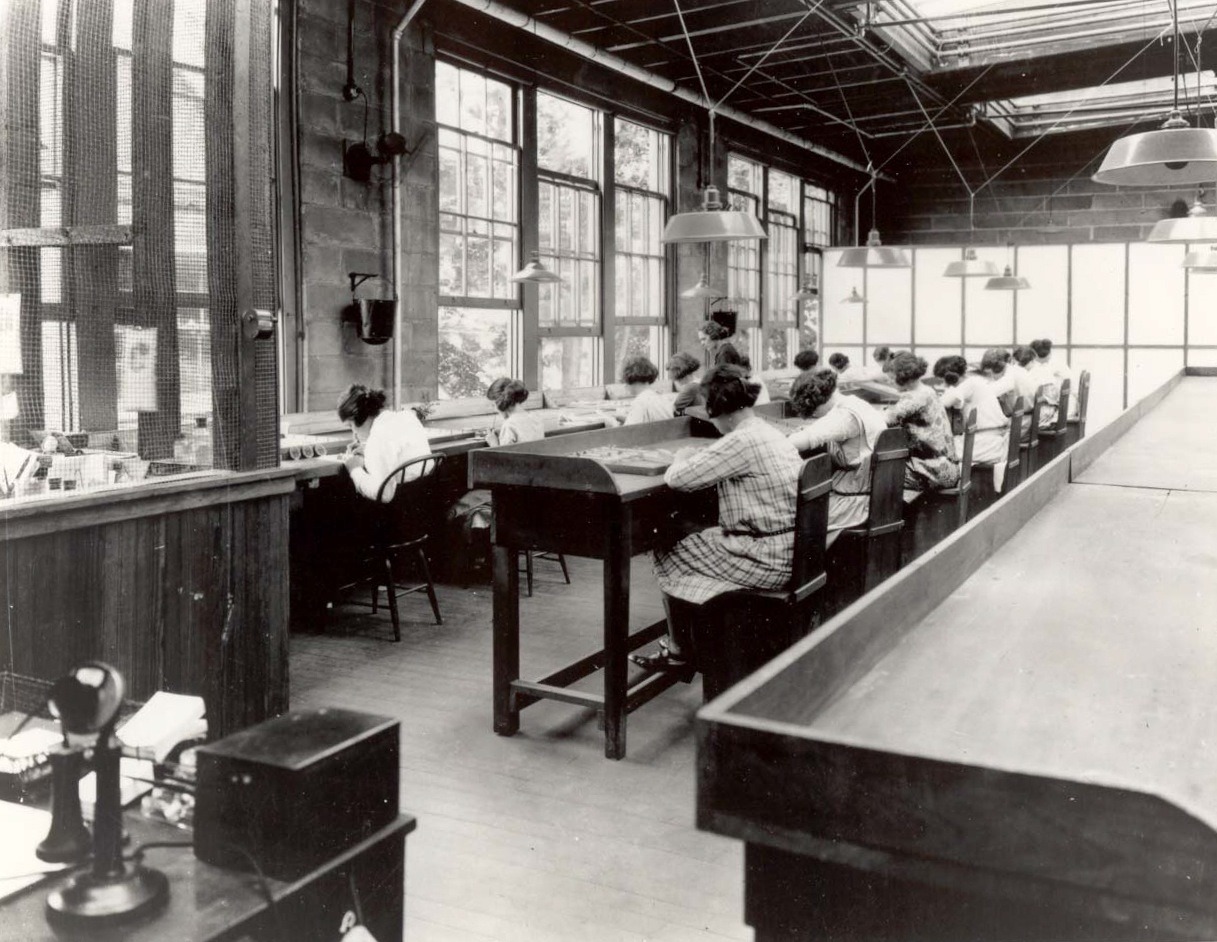
Radium dial painters in the United States Radium factory in Orange, New Jersey. Source: Rutgers Libraries
Speaking of the latter, we must mention a most peculiar material, called Radium. Radium was discovered by Pierre and Marie Curie in 1898 and less than twenty years later, in 1915, Guido Panerai patented his method that allowed covering the hands and dials of watches with this gloriously luminescent material. In short, he created a mixture of radium bromide, phosphorous zinc sulfide and mesothelium, all contained in glass tubes. This way the material could be applied and would glow heavily and constantly. We must note that radioactivity had been a little-understood phenomenon at the time and so the world of watchmaking had little factual information about it either; the result of which was indeed tragic. The half-life of radium is around 1600 years and from our perspective its most important attribute is that it glows continuously and needs not to be “charged” like other luminescent materials do. It was a tempting option for sure, so much so that the large text of Radiomir on the dials of these Panerai watches actually stood for this amazing material.
It was proven only decades later that it had some severely dangerous properties: in the manufactures primarily women painted the hands and the dials with Radium. To be able to draw sharp lines they would put the brush tips in their mouths to create a fine tip. In this way they transferred a huge amount of the strongly radioactive material into their bodies which years or decades later would cause extremely serious illnesses or deaths, even. These women were unaware of the immense danger of the material they handled day-by-day and they are often referred to as Radium girls–specifically those who worked in the United States Radium factory in Orange, New Jersey. For further details about what they had to go through, and what actually is behind the name Radiomir, as well as what effect Radium had on their lives I suggest you do a search for Radium girls as we really cannot further elaborate in this article. Eventually, radium was officially banned in the ’50s, however it remained in use by watch repairmen and in watches made for military use. Richard Paige wrote about this topic and watch luminant in general for us, here.
Another important – and certainly much brighter – advancement concerned the waterproofing of the early Panerais: this was achieved by the special “bridge” that has since then become a trademark design element for the brand. Although it was debuted by Reference 6152-1 in 1943, Panerai patented the design much later, only in 1956. Its function is rather obvious in that it was designed to hold the crown in a secured position and hence ensure that there is a constant and strong bond between the seals of the crown. Furthermore, it also allowed the crown to be used to safely wind the movement even in when it was in a secured position. Owing to these advancements, the water resistance of watches slowly but surely grew from 60 to 80 meters up to even 200 meters. In summary, with its much improved legibility and water resistance, Panerai laid down the first stones in the road that ultimately led to the divers’ watches of today.
Having said that, while the aforementioned innovations have certainly raised the bar, they also only meant the beginning. You see, despite the clever crown-guard system and the more legible dial, for the most part the Radiomirs and Luminors of the era have remained two or three-hands watches that have not provided any further useful information for the diver. The military proved to be the source for yet another (major) leap forward: this time it were the French elite divers unit called “nageurs de combat.” Established in the 1950s, they realized that in order to accomplish the demanding and trying missions that laid ahead of them they needed better, bespoke tools. The undersea missions of these specially trained frogmen included sabotage and acquiring military intelligence, for which they used waterproof compasses, depth meters and of course watches; although at the dawn of the 1950’s none of these performed up to their expectations. And let’s not forget that at the time they could not even dream of having the modern wrist-worn digital devices which today’s divers use.
Their leader, Bob Maloubier, sketched the first drawings of a watch which him and his team deemed to be the most suiting for their needs and with their idea and demands at hand he started looking for the watch company that would manufacture it for them. Following an array of refusals he met Blancpain, the then-tiny Swiss watch manufacture that would ultimately go ahead and realize Bob’s and his team’s plans, hence creating a watch which since then has undisputedly become an icon: the Fifty Fathoms. According to Blancpain, the first “real” diver’s watch was not the Rolex Submariner but rather the Fifty Fathoms from 1953 — although this claim is contradicted by recent research by Perezcope that you can find here. It was the “FF” which by some forty years has preceded (and outlined) the modern ISO 6425 standard, the standard which defines the characteristics of the modern dive watch. Why does that matter? Because it was this model which first comprised nearly all technical solutions, details which enabled wristwatches to be used for professional and hobby dives alike.
This is what the French elite frogmen required the new watch to offer: exact measurement of the dive’s time (and hence that of the oxygen supply), perfect legibility under all circumstances and finally a robust construction that ensures exceptional reliability. As in most cases, the problem here was not with achieving any one of these factors, but rather achieving them all at once. And while most features of the Fifty Fathoms were indeed developed to address the needs of Bob Maloubier and his team, we must also note that some of the following functions and solutions were coming from Jean-Jacques Fiechter, who was the director of Blancpain at the time and an experienced diver himself. Without further ado, let’s discuss these peculiar design solutions one by one, as by discovering these features we will (for the most part) learn what makes a dive watch capable of accompanying us into the depths.
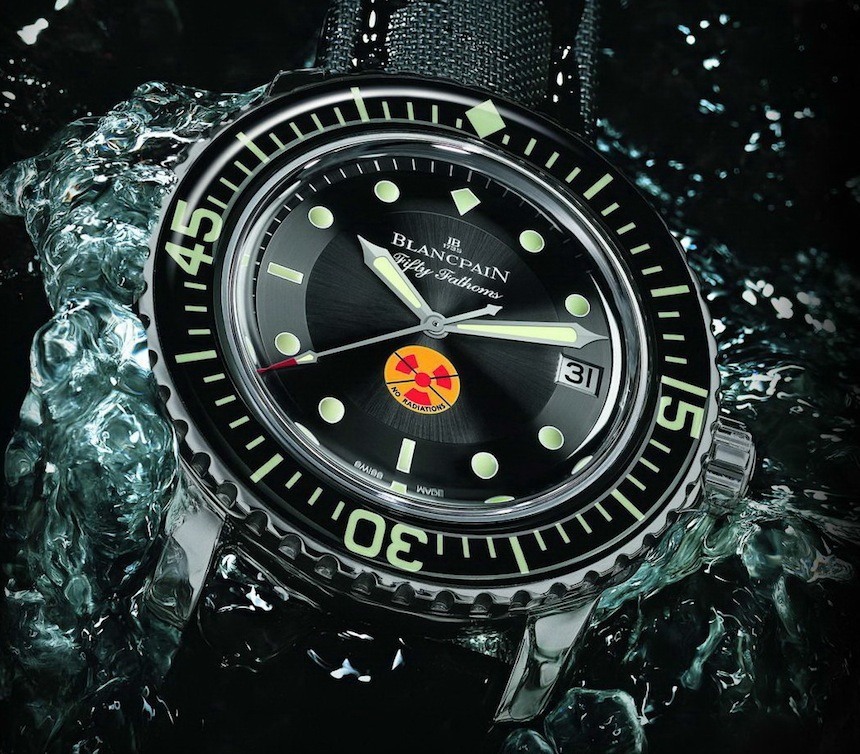
A much more modern interpretation, the Tribute to Fifty Fathoms with the “No-Rad” dial, debuted in 2010.
Today, the concept of the rotating bezel should be familiar to most, but it was the Fifty Fathoms that first incorporated it. It’s role is that it enables the wearer to measure up to 60 minutes once the shape that resembles “0” on the bezel (a diamond in the case of the FF) gets aligned with the momentary position of the minute hand. As the hand advances, it points to the minute track on the bezel, indicating the elapsed time. By now, having learned about the challenges preceding watches had to face, it is obvious that water resistance was a major issue as well. Blancpain’s answer was a double O-ring seal around the crown (as the screw-down crown’s patent still belonged to Rolex at the time), which paired with a screw-down case back made for proper resistance to larger depths. As the name suggests, the first model was resistant to a depth of fifty fathoms, the equivalent of about 91 meters–the reason being that at the time that was more than the greatest depth divers could reach with the oxygen mixture used at the time. As a completely unique movement choice back then, the watch was equipped with an automatic movement so as to reduce the wear on the seals around the crown when used for winding the movement. Last but not least, a solid case back was used (today’s more ubiquitous sapphire case backs were out of the question), hiding the movement and its antimagnetic frame which served to protect the movement from the strong magnetic fields present around different military equipment. Much like the anti-magnetic inner case, the uni-directionally rotating bezel was also Fiechter’s idea. He decided to equip the bezel with a ratchet that would allow it to be rotated only in the counter-clockwise direction, hence eliminating the possibility of it being accidentally adjusted in a way that would indicate a shorter dive-time. In other words, had the bezel been moved inadvertently, it would only indicate that the dive started a longer period ago, hence warning the diver to head for the surface soon.
Over the years, the Fifty Fathoms has been offered in a great number of different variants, among which the most interesting might be the piece which collectors simply call the “no rad”. This title refers to the rather prominent No Radiation emblem present on the dial’s 6 o’clock position (as seen on the image above). Showing the international emblem for anti-radiation, Blancpain used this to ease non-military buyers’ minds and assure them that the “FF” they bought contains no radioactive materials–once we are familiar with the previously mentioned serious issues linked to radium, it is easy to understand why customers were concerned. In summary, the Fifty Fathoms’ first full life-cycle lasted 27 years, from 1953 until the temporary shutdown of the brand in 1980. Three years later a certain Jean-Claude Biver purchased and restarted the company which, in 1997, resurrected the Fifty Fathoms and formed it into a remarkable luxury diver.
In 1954, supported by patent applications for the Submariner bezel construction dating as early as February 5, 1953 (CH305177, CH312285), Rolex debuted the watch which has since become the most widely recognized (and imitated) timepiece ever: the Submariner. While this model has also evolved in a number of ways throughout the past 60 years, it has always reserved its high-contrast dial and bezel, its unique shape and the three-link stainless steel bracelet. Much like with the Oyster, Rolex has not set off with a clean sheet of paper but rather excelled at revising and refining the countless details and features of others in a single piece. The Submariner is an amazing story all to itself (and one that Ariel discussed here) but for our present topic it is its “bigger brother” that’s more interesting, implicatively called the Deep Sea.
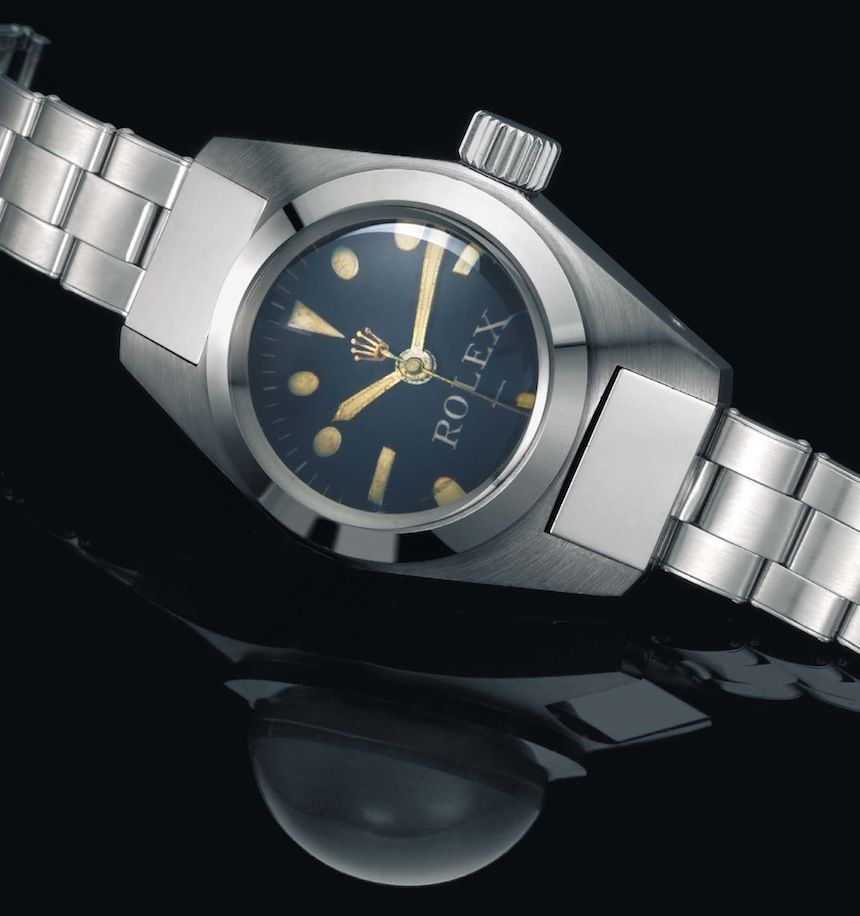
The Rolex Deep Sea Special, the first watch exposed to the crushing pressure of the Challenger Deep, some 10,900 meters below the surface.
It was the Deep Sea which defeated the incredible depths of some of the deepest points of our planet, an accomplishment no other brand or watch can claim its own. The story of the Deep Sea begins in 1960. That year on the 23rd of January, two men, Jacques Piccard and Don Walsh aboard the “Bathyscaphe Trieste” were the first to reach the deepest point on Earth: at the bottom of the Mariana-trench they have first conquered the Challenger Deep, some 10,916 meters (35,800 feet) below the surface of the Pacific Ocean! No submersible (let alone a watch!) has ever ventured to go this deep. Strapped to the outside of the special submersible was the Deep Sea Special (note that the original had its name in two as Deep Sea, unlike the newer pieces for which the words have been merged into Deepsea instead). Thanks to its massive spherical Plexiglas “crystal”, the DSS survived the crushing pressure of the deep, around 1,100 times that of what is present at the surface! In fact, the piece had to be so massive that its thickness was 3.6 centimeters, rendering it a beast of a watch.
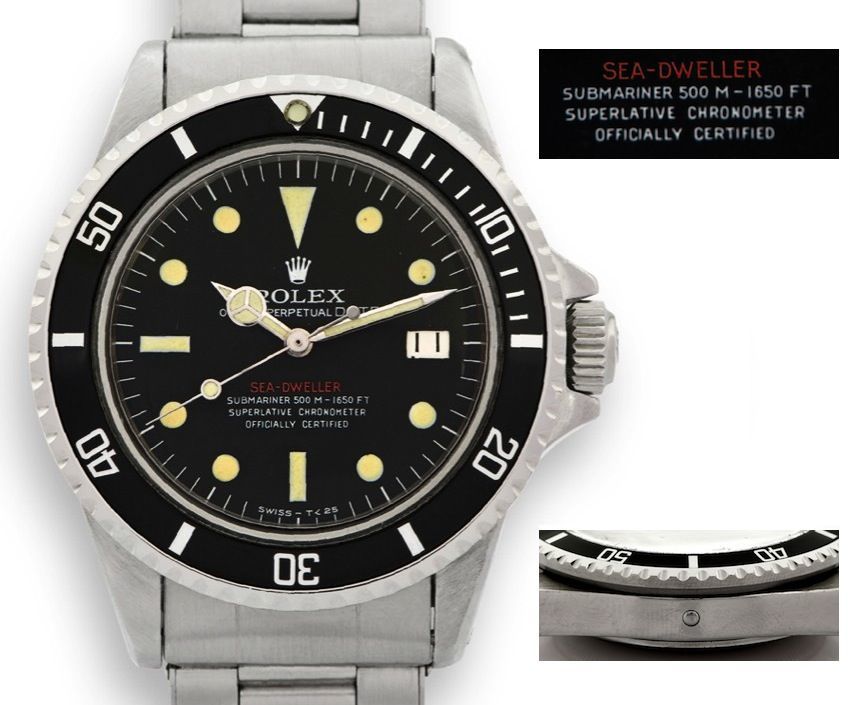
The first ever watch which Rolex has equipped with the helium escape valve: the Single Red Sea-Dweller reference 1665. Credit: Antiquorum Auctioneers
Deep water experiments were of course not terminated after the deepest point had been conquered, on the contrary! Jacques Cousteau’s name surfaces again, as he, the U.S. Navy and the French commercial diving firm COMEX (Compagnie Maritime d’Expertises) had all been working in parallel on projects dedicated to developing ways for humans to live on the ocean floor. The story goes that COMEX divers working at great depths were breathing a mixture of oxygen and helium, allowing them to stay down for much extended periods of time (we are talking about several days here) without having to come up to the surface to decompress.
The problem this created was that helium (as the smallest natural gas particles found in nature) could penetrate even the most tightly sealed watch case and build up on the inside. As the divers ultimately headed towards the surface the helium inside their watches expanded and hence increased the pressure inside the watch, hence looking for a way out with an ever increasing force. Sooner or later something had to give and more often than not it was the crystals of the watches, popping out while the divers were still in the water, on their way up. A solution needed to be found quickly and two firms, Rolex and Doxa, both set out to tackle this challenge.
There is no official information as to whether the two companies have co-operated in developing the solution, but considering the timing and that they both had been working with Jacques Cousteau and his team implies that there may have been some (or considerable) co-operation. What we now is that, unsurprisingly, both Rolex and Doxa claim their respective watches to be the first equipped with what eventually became the solution to the issue: called the helium release valve, this one-way valve set at the 9 o’clock position of the case allowed helium to escape from the case, hence leaving the crystal and all other components intact. Furthermore, as seen on the image above, in 1969 it was Doxa who patented the design, a notable detail as most still credit the invention to Rolex.
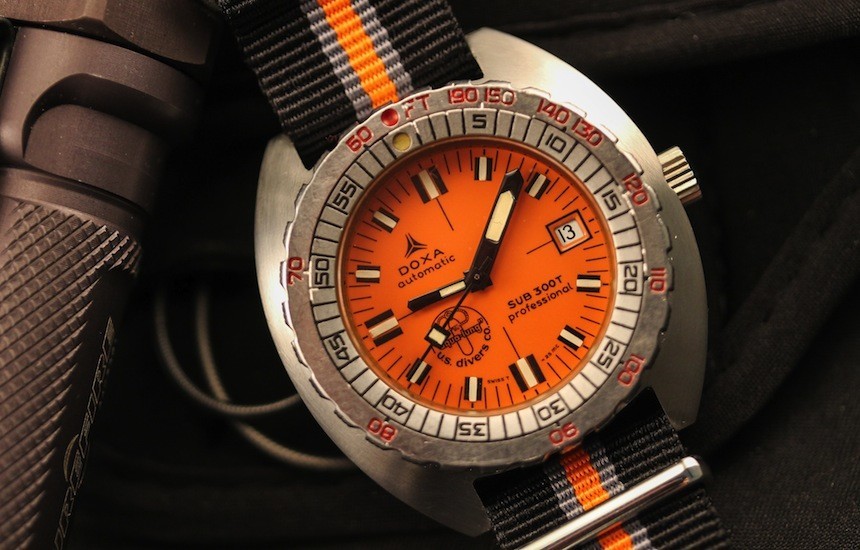
The Doxa Sub-300T with its decompression scale on the bezel and of course its trademark orange dial featuring the “aqua-lung” logo. Credit: analogshift.com
As we said, Doxa’s achievements are often disregarded or forgotten, primarily because the brand went under (no pun intended) in the 1970’s, where others kept the steam in their marketing machines. But this is not to say that this unique Swiss brand is not worthy of our attention, as proven by the dedicated enthusiasts and collectors of the brand. In short, the first commercially available wristwatch with a helium release valve was produced by Doxa in 1969, called the Sub 300T Conquistador, preceding the Sea Dweller by some two years. The Conquistador offered, beyond the HRV, a unique uni-directional bezel, featuring a no-decompression table. It was developed in conjunction with the US Divers Company, and it is used to help divers determine the longest time that they can spend immersed before having to head towards the surface.
The diver lines up the “0” marking on the bezel with the minute hand at the time he starts his dive–just like as he would with any normal dive watch. Once the two are lined up, the scale on the bezel indicates that, based on the depth of his dive, at what time he must terminate the dive so as to not have to take decompression stops. Staying under for any longer would mean that he cannot come to the surface in one take but he must take decompression stops instead. It was a clever idea and one that shows that professionals were involved in the making of the Conquistador. Actually, the pros liked it so much that the US Divers Company actually started exclusively marketing the orange dialed Doxa as “The US Divers Doxa”.
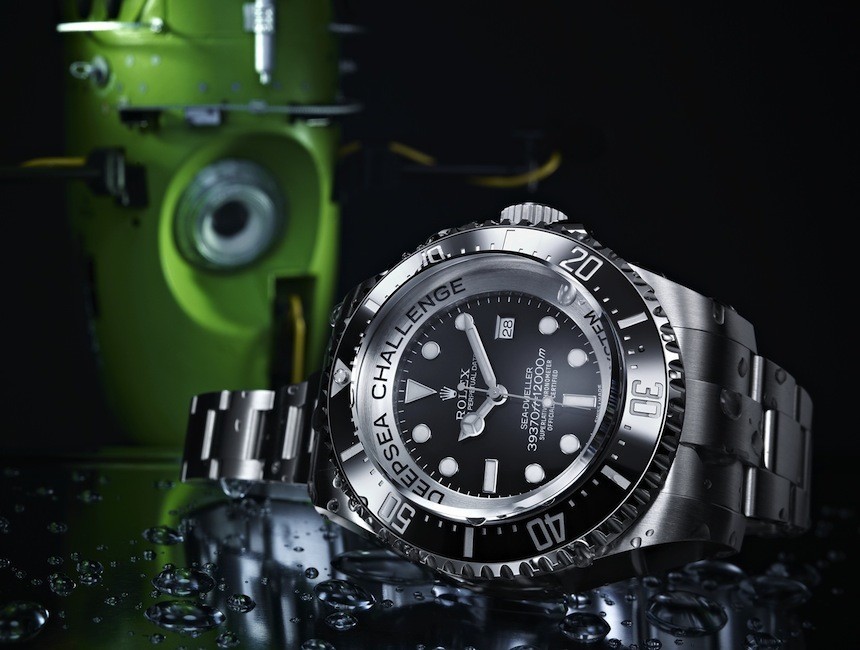
The Rolex Deepsea Challenge watch with the Deepsea Challenger submersible in the background. These machines have visited the deepest point on Earth on 26 March, 2012.
It took as much as 52 years for another manned visit to the Challenger Deep to be undertaken: on the 26th of March, 2012, the famous director James Cameron ventured to pay a visit to the deepest place on our planet. Rolex was admittedly rather late to party as they joined the initiative only 5 weeks prior to the dive, consequently having only an extremely limited time to design, test and manufacture another, more modern watch that would be able to accompany Cameron and withstand the immensely challenging conditions.
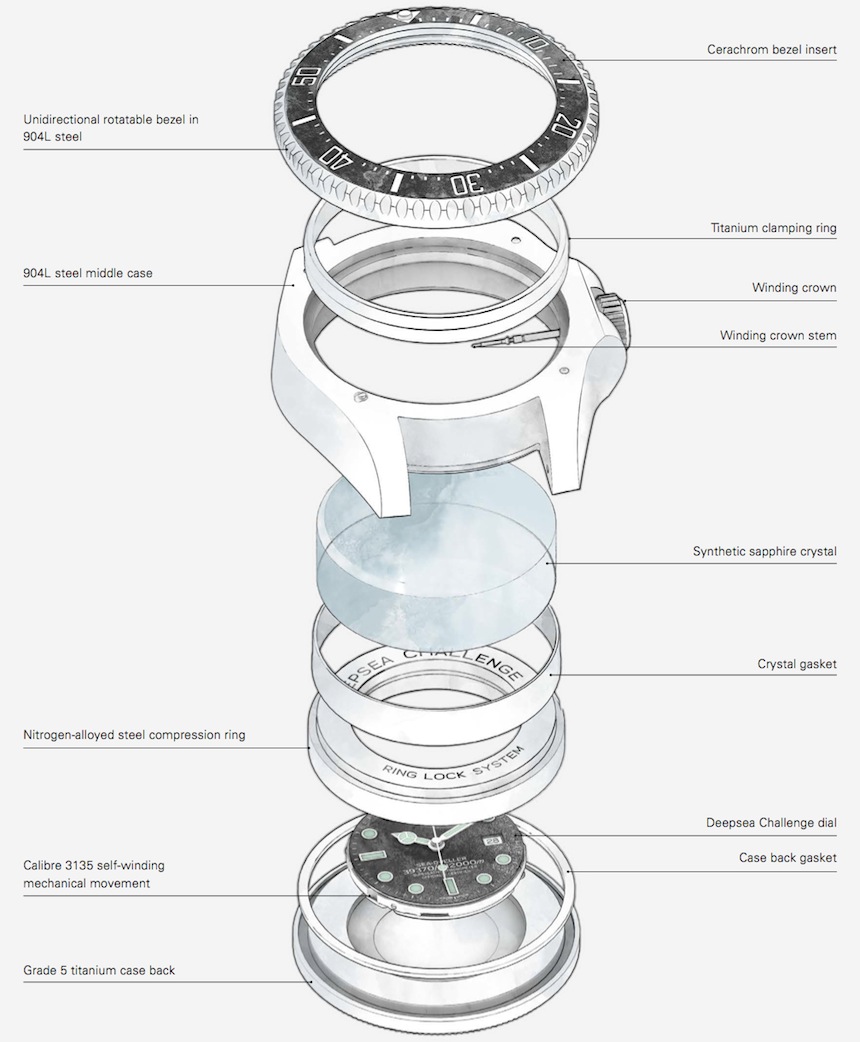
An image you have likely not seen anywhere else: the exploded view on the construction of the Deepsea Challenge; one mighty package capable of handling 1,200 times the pressure present on the surface.
The result was a modified version of the Deepsea which Rolex first debuted in 2008. The Deepsea Challenge as it was called was equipped with a 1.5 centimeters thick sapphire crystal fitted to a rather huge (by Rolex-standards simply gargantuan) 51.4 millimeter wide and 28.5 millimeter thick case and hence it ultimately offered a water resistance of 12,000 meters; just in case the Challenger Deep had another 1,000 meters left, you know. Strapped to the robotic arm of the Deepsea Challenger (we have ran out of permutations of these two words by now, we promise), the watch spent more than three hours at the depth of 10,908 meters and of course withstood the couple hours long descent and ascent as well, only to resurface again, ticking away as if nothing had happened.

By now we have become familiar with the absolute extremes, so now let’s close this feature article with some insight into the world of the more widely available dive watches of today. As we mentioned upon discussing the Blancpain Fifty Fathoms, it is the ISO 6425 standard which defines what a “true divers’ watch” is and what tests it must pass before it can be made available for purchase. Introduced in 1996, it defines a dive watch as a watch designed to withstand diving in water at depths of at least 100 m and possessing a system to time dives. It also requires the following functions to remain legible in the dark from a distance of 25 centimeters or 9.84 inches: the indication of time, meaning that the hour and minute hands are easy to distinguish and are perfectly legible, an indication that the watch is running (usually achieved by a lumed running seconds hand), set time of the time-preselecting device, i.e. the markings on the bezel, and finally the end-of-life indication in case the watch is battery-powered. This already is a generous amount of strict prerequisites but things get all the more complicated once we acquaint ourselves with the testing requirements set specifically for this type of watches.
The best way to understand this is to compare the tests that ordinary “waterproof” watches and designated dive watches are subjected to. To begin with, watches designed solely for everyday use are immersed in water at a depth of 10 centimeters for 1 hour, while dive watches spend 50 hours at a depth of 30 centimeters. As you can tell, this is performed to test the quality of the seals, as there is no point to test them to hundreds of meters if they cannot isolate water at negligible depths, albeit at expanded periods of time. Dive watches are tested before and after the immersion test for condensation as they are heated up to 45 degree Celsius and a drop of water (of between 18 and 25 °C) is placed on their crystal, while normal watches are tested only once, separately. After a minute or so the drop of water is wiped off and the watch has to remain dry on the inside, meaning that if condensation is visible on the inner side of the crystal the watch has failed the test.
Once these are done it is time for the “real deal”, the overpressure test. Normal watches are tested for their rated pressure for 10 minutes and that’s that. Dive watches, however, are immersed into water and within 1 minute are subjected to 125% of their rated pressure (meaning that a watch rated for 300 meters will be tested for 375 meters) and be held under that pressure for two hours; clearly a major difference compared to the negligible 10 minutes set for ordinary watches. Once the two hours have passed the watch is not removed from the testing vessel but rather held at 0.3 bars for another hour. Needless to say, absolutely no intrusion of water or condensation is acceptable. Furthermore, the crown and other “setting devices” are also tested in a separate test whereas they are subjected to the same over-pressure test, albeit this time around it lasts 10 minutes only, while a pressure of 5N is applied to the crown and other user-operated components. No intrusion or condensation is acceptable this time around either. And while there are a number of other more subtle tests, at last we will mention the test to define the watch’s resistance to magnetic fields, as they are subjected to 3 expositions to a direct current magnetic field of 4,800 A/m. The watch must keep its accuracy to within 30 seconds per day as measured before the tests have been undertaken.
Wow. Let’s relax now and do not forget to breathe in and out after this rather heavy dose of information; just like those elite divers would, undertaking one of their secret under-water missions! Surely, there are many sublime dive watches out there which rightfully enjoy an iconic status, which we simply could not discuss at length here, and yet, with that said we do hope that you enjoyed this comprehensive look at some of the cornerstones in the history of waterproof and dive watches; and that it will help you further appreciate this clearly very special group of timepieces. Whether you expose them to the challenging depths frequently or just have them accompany you in your aboveground life, you may rest assured that they will always be there for you as a most reliable companion.

